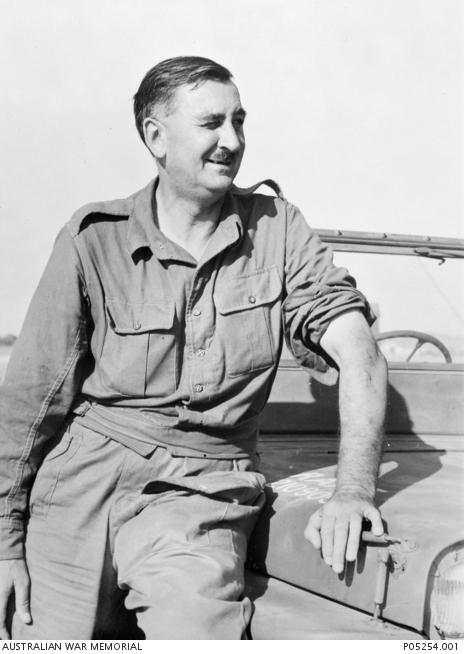| Accession Number | P05254.001 |
|---|---|
| Collection type | Photograph |
| Object type | |
| Maker |
RAAF Official photograph |
| Place made | Australia: Queensland, North Queensland, Bowen |
| Date made | 18 December 1944 |
| Conflict |
Second World War, 1939-1945 |
| Copyright |
Item copyright: Copyright expired - public domain
|
Informal portrait of Mr James Davidson-Pratt, Controller of Chemical Defence, Porton Down and the ...

Informal portrait of Mr James Davidson-Pratt, Controller of Chemical Defence, Porton Down and the representative of the British Ministry of Supply, leans against a United States Truck, ¼ ton (Jeep). His sleeve is rolled up showing scars from mustard gas patch experiments. It was commonplace for chemistry warfare personnel to experiment on themselves until it was realised that they become less tolerant to the chemicals. Davidson-Pratt believed that the results from experiments and work done by Major F S Gorill on volunteers at Townsville, Qld, in early 1943 were a major breakthrough in understanding chemical warfare. As a result the British government considered the investigation of offensive and defensive aspects of tropical chemical warfare in Australia as highly desirable. This led to Prime Minister Curtin's approval of the Australian Defence Committee to begin larger scale experiments with international co operation in April 1943. Temporary Headquarters of the Australian Chemical Warfare Research and Experimental Section was set up at Innisfail, Qld in October 1943. Gunyarra, south of Proserpine, Qld, the permanent field station to test mainly British equipment was opened in January 1945 and chemical warfare experiments were carried out by the 1st Field Trials Company, Royal Australian Engineers (RAE).
- Large cylinders used to contain chemical agents, and hundreds of contaminated drums used for ...
- Informal group portrait probably of the members of the Course of instruction in chemical warfare ...
- Informal group portrait of RAAF members standing on the wing of a DAP Beaufort bomber aircraft at ...
- The starboard side of the fuselage of a DAP Beaufort bomber aircraft at an unknown airfield, ...
- An unidentified person wearing protective clothing, using a high pressure hose to decontaminate a ...
- The gauge pressure 65 pound bomb L.C., shaped like a five gallon petrol can, was initially used ...
- A stack of wooden boxes containing hexagonal bars, probably at Proserpine, Qld. In the background ...
- Stacks of wooden boxes each containing two 23pound M72 bombs, probably at Proserpine, Qld. ...
- Group of 23 pound aerial delivery canisters with a cap at one end with fins, stand against stacks ...
- A gas cylinder is being held stable by someone wearing protective gloves and clothing while ...
- A mustard gas evaporation point set up in the savannah at the Permanent Chemical Warfare Station, ...
- Ken James, munitions expert (UK) (right) examines a fuse, while an unidentified soldier (left) ...
- A mixing machine (a small belt motor driving a belt, supported on a metal strip) stirs an unknown ...
- Large cylinders used to contain chemical agents, and hundreds of contaminated drums used for ...
- Smoke billows from a fire which is burning chemical warfare stocks in the bush and savannah. ...
